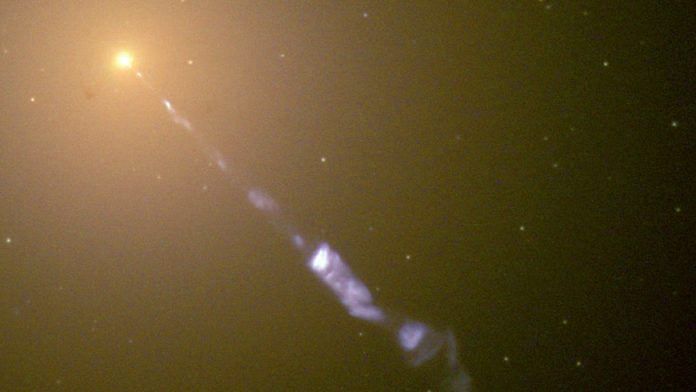New Delhi: The Big Bang was the moment when the universe was born, and since then the cosmos has been in a state of constant expansion. But while this has been well known for about a century, nobody really knows definitively at what rate the universe is expanding.
For the first time, however, a team of researchers from India has proposed a method, using gravitational waves from binary black holes, that could potentially determine the rate at which the universe expands.
The researchers were led by Souvik Jana, a PhD scholar at Bengaluru’s International Centre for Theoretical Sciences (ICTS), which comes under the Tata Institute of Fundamental Research. His team collaborated with researchers from the Inter-University Centre for Astronomy and Astrophysics (IUCAA), and University of California in Santa Barbara.
Their work was published in the journal Physical Review Letters on 30 June.
Gravitational waves are invisible ripples in space that travel at the speed of light and were first detected in 2015. Before that, all inferences about the universe were based on observations of electromagnetic energy.
Gravitational waves are made of energy and are shot out in major events, such as the merging of black holes. The team of researchers suggests that the study of “gravitational lensing” can help determine the universe’s expansion rate.
Essentially, when gravitational waves bump into large masses of matter like galaxies, instead of being absorbed, their paths deviate, just like light, allowing more gravitational waves to form. This is called “gravitational lensing”.
According to the researchers, the energy released by the collision of neutron stars or black holes can be used to estimate the distance to these bodies, owing to gravitational lensing. They propose that the multiple gravitational waves released from binary black holes reach earth at various time stamps and can be used to calculate the expansion rate of the universe.
Team lead Souvik Jana said in a release to the media that “the method does not require knowing the properties of individual galaxies which create multiple copies of gravitational waves, the distances to the black hole pairs, or even their exact location in the sky. Instead, it only requires an accurate method of knowing which signals are lensed”.
In a communication over email with ThePrint, Parameswaran Ajith, astrophysicist at the International Center for Theoretical Sciences (ICTS) and part of Jana’s team, said: “Einstein’s theory of gravity predicted that massive objects act as a lens to focus light. The gravitational lensing of light has emerged to be a powerful tool to probe the cosmos — it has been used to detect planets outside the solar system, dark matter in galaxies, etc. According to Einstein’s theory, massive objects should focus on gravitational waves also.”
Gravitational lensing has so far not been detected or observed.
Ajith said, “we have not seen this yet; however, the first observation (of gravitational lensing) is expected in the next few years”.
The researchers pointed out that the method will only become applicable when millions of binary black hole mergers are detected. A binary black hole is a system of two black holes in close orbit around each other.
So far, the National Science Foundation’s LIGO (Laser Interferometer Gravitational-Wave Observatory) and the Europe-based VIRGO gravitational-wave detector have stumbled upon 100 binary black hole mergers, according to the researchers.
The researchers said a future generation of upgraded detectors will begin their search for merging black holes within the next decade.
“These next-generation detectors are like LIGO, but with much better sensitivities that will allow them to see out to larger distances. These are different from pulsar timing arrays, which typically observe supermassive black holes,” Shasvath J. Kapadia, a professor at IUCAA and one of the researchers, told ThePrint..
Last month, scientists said they had discovered clear evidence of the long-hypothesised background “hum” of nanohertz gravity waves, referring to persistent ultra-low frequency ripples in spacetime that travel throughout the cosmos continually from various sources all around us.
The discovery was the result of a worldwide effort, with special contribution from the Indo-Japanese Pulsar Timing Array (InPTA) teams via the Pune-based GMRT telescope.
Also Read: NASA reveals new spacesuit for human mission to Moon & traces of glacier found near Mars’s equator
The Hubble constant problem
The researchers’ theory might just solve the age-old problem of the Hubble tension — discrepancies in the value of the expansion rate of the universe, known as the Hubble constant, proposed by scientists over time.
There are primarily two astronomical methods to measure cosmic distances, which can, in turn, provide clues to understanding the expansion of the universe, and figuring out the Hubble constant.
The first method looks at objects whose lengths are known and simply examines how large they seem in the sky. These items are features of cosmic background radiation, or of how galaxies are distributed throughout the cosmos.
A second method uses the luminosity of celestial objects to determine their distances from the earth, based on how bright they are.
There are also various ways of calculating the Hubble constant. While one uses gravitational waves, another method compares distances to the apparent recessional velocity of the target galaxies — meaning how fast the galaxies seem to be moving away.
(Edited by Nida Fatima Siddiqui)
Also Read: How a capsule tied to a Boeing 747-sized balloon will herald edge of space tourism in India



